
Asia Africa and Middle East: Singapore Cruise
Disney Cruise Line
Sail round-trip from Singapore on an unforgettable holiday aboard the Disney Adventure. From spectacular entertainment and exciting deck parties to imaginative dining and fun-filled Character encounters, a Disney Cruise offers something for everyone in the whole family.

Executive Member Benefit
Executive Members receive an annual 2% Reward, up to $1,250, on qualified Costco Travel purchases
Digital Costco Shop Card
Member Exclusive: Digital Costco Shop Card, courtesy of Costco Travel, with every Disney Cruise Line sailing†
Sailing Itinerary

Note: Cruise itineraries are subject to change. Please verify ports and times directly with the cruise line.
Overview
Though physically small, Singapore is an economic giant. It has been Southeast Asia's most modern city for over a century. The city blends Malay, Chinese, Arab, Indian, and English cultures and religions. Its unique ethnic tapestry affords visitors a wide array of sightseeing and culinary opportunities from which to choose. A full calendar of traditional festivals and holidays celebrated throughout the year adds to its cultural appeal. In addition, Singapore offers luxury hotels, delectable cuisine,e, and great shopping! Located at the tip of the Malay Peninsula, Singapore's tropical climate welcomes both leisure and business travelers year-round. The island republic's excellent infrastructure enables visitors to enjoy its many sites and attractions in a safe, clean, and green environment. Award-winning Changi Airport provides air links to major cities around the world. The train and subway systems are clean, fast,t and efficient. In addition, its state-of-the-art cruise terminal has established Singapore as one of the premier cruising centers in Southeast Asia and an exciting port of call on any Asian cruise itinerary. In the city, there is no need for a car. Public transportation is excellent and walking is a good way to explore the city. All major attractions are also accessible by tour bus. Since the city is only 60 miles (100k) from the equator, the tropical temperatures do not vary much. Rainfall is fairly evenly distributed throughout the year. No matter when you choose to visit, warm weather will be abundantly available. The visitor is struck immediately by Singapore's abundance of parks, nature reserves, and lush, tropical greenery. Singapore's progress over the past three decades has been remarkable, yet the island has not been overwhelmed by development. Visitors will discover a wealth of historical treasures from the past, in the beauty of older buildings, values, and traditions that have survived in the face of profound social and geographical change. Lacking any noteworthy natural resources, Singapore's early prosperity was based on a vigorous free trade policy, put in place in 1819 when Sir Stamford Raffles first established it as a British trading post. Later, mass industrialization bolstered the economy, and today the state boasts the world's second busiest port after Rotterdam, minimal unemployment, and a super-efficient infrastructure. Almost the entire population lives in upscale new apartments, and the average per capita income is over US$12,000. Singapore is a clean, safe place to visit, its amenities are second to none and its public places are smoke-free and hygienic. Forming the core of downtown Singapore is the Colonial District. Each surrounding enclave has its distinct flavor, from the aromatic spice stores of Little India to the tumbledown backstreets of Chinatown, where it is still possible to find calligraphers and fortune tellers, or the Arab Quarter, whose cluttered stores sell fine cloths and silks. North of the city, are two nature preserves, Bukit Timah and the Central Catchment Area, along with the splendid Singapore Zoological Gardens. The East Coast features good seafood restaurants set on long stretches of sandy beach. In addition, there are over fifty islands and islets within Singaporean waters, all of which can be reached with varying degrees of ease. Day trips are popular to Sentosa, the island amusement arcade which is linked to the south coast by a short causeway and cable car. Music, theater, and nightlife: all are abundant in this remarkable city. Singapore used to be considered a "stopover" on the way to larger Asian cities. This is no longer true! Visitors seek out Singapore for business and finance and also for a fascinating and satisfying vacation for the whole family. Strategically located at the southern tip of the Malay Peninsula sixty miles from the equator, Singapore has for centuries been a crossroads between East and West. Chinese traders en route to India had navigated its waters from at least the 5th century. In the 14th century, it was part of the powerful Vijayan Empire and was known as Temasek or Sea Town. Legend has it that it was renamed Singa Pura or Lion City after a visiting Sumatran prince saw an animal he mistook for a lion, an animal considered a good omen. Modern Singapore came into being in 1819 when Sir Stamford Raffles claimed what was then a small fishing village as a regional base for the East India Company. The island's natural harbor and location made it an ideal site for a trading post serving British trade interests between China, the Malay world, and India. Singapore flourished as its free trade policy attracted merchants and residents from all over the world. Raffles initiated a town plan which included leveling one hill to form a new commercial district (now Raffles Place) and constructing government buildings around another hill (now called Fort Canning Hill). The British plan also involved separating the population according to ethnic categories with Europeans, Indians, Chinese,e, and Malays each living and working in the distinct quarters of the city. Revenues soared in the ensuing years from the production of opium and rubber. Millionaires were made overnight. Immigration rose steadily. The island became Britain's strategic defense base in the Far East but fell to the Japanese in 1942. After the world war ended in 1945, Singapore became a crown colony. It gained self-governing status in 1959 and independence in 1965 when it became part of the new state of Malaysia which united Malaya with Singapore, Sabah, and Sarawak. The alliance did not last. Singapore was used to being on its own, and within two years the island set up its stable government and became known as the Republic of Singapore. Under Prime Minister Lee Kuan Yew's leadership, Singapore continued to strengthen its infrastructure and its industrial base. Housing and urban renovation kept pace with population growth. The areas of health and education are strong. Singapore's leaders have also brought order and progress through strict regulation of social behavior. Smoking in public was banned, as was gum chewing. High economic growth rates have supported political stability. Singapore is the world's second busiest seaport and has an airport served by over 50 major airlines. It has state-of-the-art communication and mass transit systems. It is Asia's premier center for finance and business and the world's third-largest oil refining center. Over 7 million visit the tiny island every year.
Overview
Though physically small, Singapore is an economic giant. It has been Southeast Asia's most modern city for over a century. The city blends Malay, Chinese, Arab, Indian, and English cultures and religions. Its unique ethnic tapestry affords visitors a wide array of sightseeing and culinary opportunities from which to choose. A full calendar of traditional festivals and holidays celebrated throughout the year adds to its cultural appeal. In addition, Singapore offers luxury hotels, delectable cuisine,e, and great shopping! Located at the tip of the Malay Peninsula, Singapore's tropical climate welcomes both leisure and business travelers year-round. The island republic's excellent infrastructure enables visitors to enjoy its many sites and attractions in a safe, clean, and green environment. Award-winning Changi Airport provides air links to major cities around the world. The train and subway systems are clean, fast,t and efficient. In addition, its state-of-the-art cruise terminal has established Singapore as one of the premier cruising centers in Southeast Asia and an exciting port of call on any Asian cruise itinerary. In the city, there is no need for a car. Public transportation is excellent and walking is a good way to explore the city. All major attractions are also accessible by tour bus. Since the city is only 60 miles (100k) from the equator, the tropical temperatures do not vary much. Rainfall is fairly evenly distributed throughout the year. No matter when you choose to visit, warm weather will be abundantly available. The visitor is struck immediately by Singapore's abundance of parks, nature reserves, and lush, tropical greenery. Singapore's progress over the past three decades has been remarkable, yet the island has not been overwhelmed by development. Visitors will discover a wealth of historical treasures from the past, in the beauty of older buildings, values, and traditions that have survived in the face of profound social and geographical change. Lacking any noteworthy natural resources, Singapore's early prosperity was based on a vigorous free trade policy, put in place in 1819 when Sir Stamford Raffles first established it as a British trading post. Later, mass industrialization bolstered the economy, and today the state boasts the world's second busiest port after Rotterdam, minimal unemployment, and a super-efficient infrastructure. Almost the entire population lives in upscale new apartments, and the average per capita income is over US$12,000. Singapore is a clean, safe place to visit, its amenities are second to none and its public places are smoke-free and hygienic. Forming the core of downtown Singapore is the Colonial District. Each surrounding enclave has its distinct flavor, from the aromatic spice stores of Little India to the tumbledown backstreets of Chinatown, where it is still possible to find calligraphers and fortune tellers, or the Arab Quarter, whose cluttered stores sell fine cloths and silks. North of the city, are two nature preserves, Bukit Timah and the Central Catchment Area, along with the splendid Singapore Zoological Gardens. The East Coast features good seafood restaurants set on long stretches of sandy beach. In addition, there are over fifty islands and islets within Singaporean waters, all of which can be reached with varying degrees of ease. Day trips are popular to Sentosa, the island amusement arcade which is linked to the south coast by a short causeway and cable car. Music, theater, and nightlife: all are abundant in this remarkable city. Singapore used to be considered a "stopover" on the way to larger Asian cities. This is no longer true! Visitors seek out Singapore for business and finance and also for a fascinating and satisfying vacation for the whole family. Strategically located at the southern tip of the Malay Peninsula sixty miles from the equator, Singapore has for centuries been a crossroads between East and West. Chinese traders en route to India had navigated its waters from at least the 5th century. In the 14th century, it was part of the powerful Vijayan Empire and was known as Temasek or Sea Town. Legend has it that it was renamed Singa Pura or Lion City after a visiting Sumatran prince saw an animal he mistook for a lion, an animal considered a good omen. Modern Singapore came into being in 1819 when Sir Stamford Raffles claimed what was then a small fishing village as a regional base for the East India Company. The island's natural harbor and location made it an ideal site for a trading post serving British trade interests between China, the Malay world, and India. Singapore flourished as its free trade policy attracted merchants and residents from all over the world. Raffles initiated a town plan which included leveling one hill to form a new commercial district (now Raffles Place) and constructing government buildings around another hill (now called Fort Canning Hill). The British plan also involved separating the population according to ethnic categories with Europeans, Indians, Chinese,e, and Malays each living and working in the distinct quarters of the city. Revenues soared in the ensuing years from the production of opium and rubber. Millionaires were made overnight. Immigration rose steadily. The island became Britain's strategic defense base in the Far East but fell to the Japanese in 1942. After the world war ended in 1945, Singapore became a crown colony. It gained self-governing status in 1959 and independence in 1965 when it became part of the new state of Malaysia which united Malaya with Singapore, Sabah, and Sarawak. The alliance did not last. Singapore was used to being on its own, and within two years the island set up its stable government and became known as the Republic of Singapore. Under Prime Minister Lee Kuan Yew's leadership, Singapore continued to strengthen its infrastructure and its industrial base. Housing and urban renovation kept pace with population growth. The areas of health and education are strong. Singapore's leaders have also brought order and progress through strict regulation of social behavior. Smoking in public was banned, as was gum chewing. High economic growth rates have supported political stability. Singapore is the world's second busiest seaport and has an airport served by over 50 major airlines. It has state-of-the-art communication and mass transit systems. It is Asia's premier center for finance and business and the world's third-largest oil refining center. Over 7 million visit the tiny island every year.
Onboard the Disney Adventure
Disney Adventure
Year Built: 2025
Double Occupancy Capacity: 6700
When Guests step aboard the Disney Adventure — the first Disney Cruise Line ship to sail from Asia — they’ll find themselves at the heart of an unforgettable journey. As the voyage begins and fantasy takes hold, their dream vacation becomes a dazzling reality — where every moment is both a journey and a destination. Through the magic of imagination, discovery, fantasy, and — of course — adventure, this spellbinding voyage will enchant Guests with memories that only Disney can create. And no matter where the magic may guide them, the stories will stay with them forever.
Activities & Services (included in cruise)
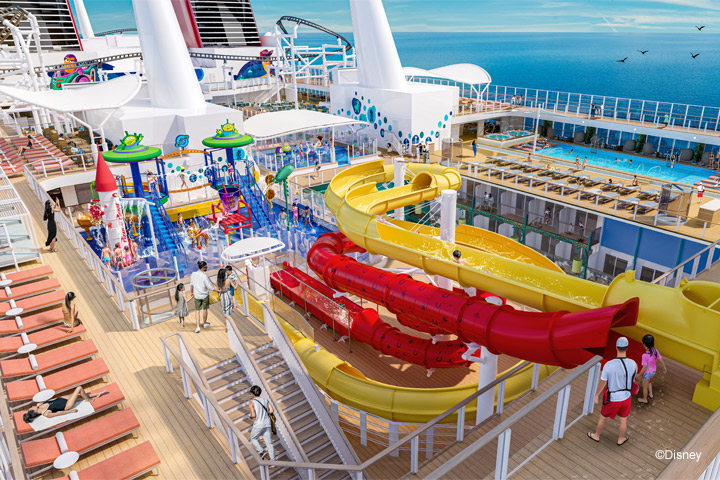
- Movies
- Theater/Show Lounge
- Fitness Center
- Pool - Children's
- Pool - Outdoor
- Water Park Arena
- Water Slide
- Babysitting
- Children's Indoor Play Area
- Children's Outdoor Play Area
- Organized Age Specific Activities
- Teen Center or Disco
- Teen Programs
- Concierge Desk
- Duty-Free Shops/Boutiques
- Elevators
Activities & Services (available for an extra fee)
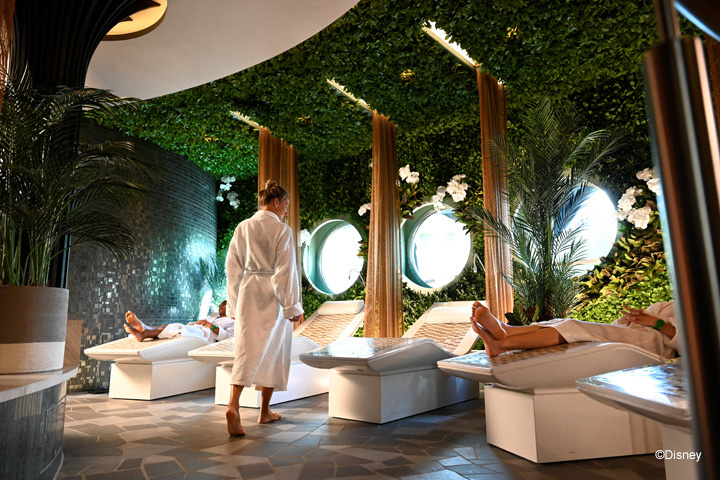
- Game Arcade
- Spa Services/Massage
- Bars/Lounges
- Infirmary/Medical Center
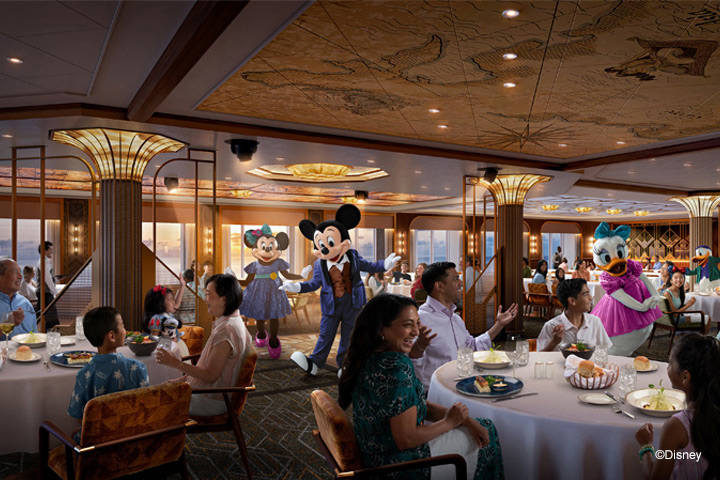
Main Dining
Hollywood Spotlight Club: Glitz and glamor await at Hollywood Spotlight Club, an exclusive dining club evoking the golden age of Hollywood. As the meal begins, so does the show, with Mickey Mouse and some of his friends dressed to the nines taking to the stage for an unforgettable musical performance celebrating family, friends, and fun.
Navigator's Club: At Navigator’s Club, Guests will be transported back to the golden age of cruising. In keeping with the maritime tradition of exclusive “Captain’s Table” dinners, Guests will be treated to exciting tales and musical performances featuring globe-trotting Mickey Mouse and his friends.
Animator’s Palate: The legacies of Disney and Pixar animation are celebrated at Animator’s Palate. As the evening unfolds, this elegant dining room transforms from black-and-white to vibrant, full-spectrum color. Surrounded by artwork and props from favorite Disney and Pixar movies, every detail pays homage to the magic of filmmaking.
Animator's Table: Guests are sure to be captivated by the timeless magic of ink-and-paint animation at Animator’s Table. Here, Guests’ hand-drawn sketches come alive as vibrant animations right before their eyes. This intimate dining gallery is adorned with authentic artwork from iconic films, creating an atmosphere that celebrates creativity and sparks imagination.
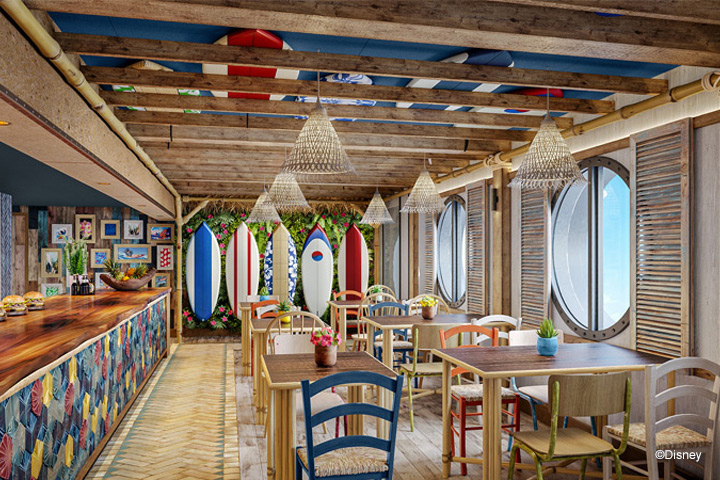
Specialty Dining
Mike & Sulley's Flavors of Asia: Inspired by the famous Japanese-style eatery in Pixar’s “Monsters, Inc.,” this family-friendly restaurant celebrates world-renowned Asian cuisines in three distinct dining experiences: a full-service Japanese steakhouse, a lively teppanyaki room, and a chic sushi and sake bar.
Palo Trattoria: At Palo Trattoria, adults aged 18 and older can indulge in an artfully crafted menu featuring antipasti, pastas, pizzas, seafood, and steaks, all paired with a curated selection of fine Italian wines and bold craft beers
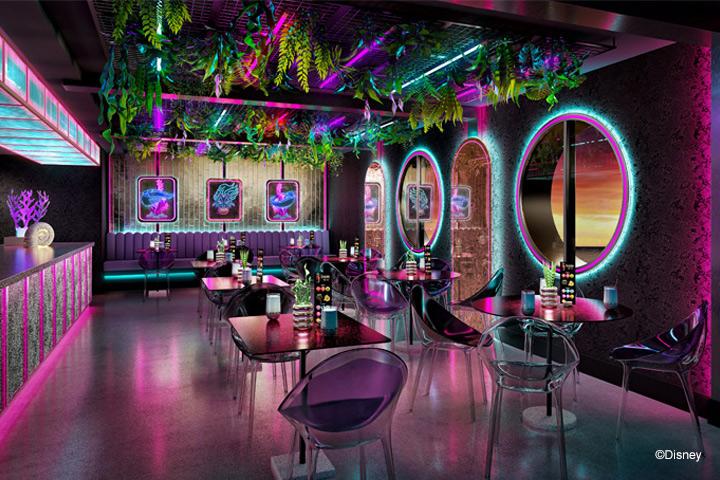
Casual Dining
Enchanted Summer Restaurant: Restaurant Description: At the Enchanted Summer Restaurant, two distinct dining rooms inspired by Disney’s “Tangled” and “Frozen” await, letting Guests revel in the charm of a cozy, village dining hall, where the joy of summer is everlasting.
Pixar Market Restaurant: Pixar Market Restaurant celebrates the imaginative spirit of Pixar Animation Studios, evoking the charm of many beloved Pixar films. By day, it offers buffet-style breakfast and lunch service. In the evening, it offers an exceptional dinner menu.
Buccaneer Bar: Guests can kick up their boots and celebrate with hearty cheer as they sip on high-end brews and watch live sporting events in swashbuckling style at this pirate-inspired bar, one of many lounges on board.
Gramma Tala’s Kitchen: Inspired by Disney’s “Moana,” this location features Asian and South Pacific flavors, served up fast.
Mowgli’s Eatery: Inspired by Disney’s “The Jungle Book,” this eatery serves rich Indian, vegetarian, and regional dishes.
Stitch’s ‘Ohana Grill: This go-to dining spot features classic American fare with a touch of island flare.
Bewitching Boba & Brews: In an electric café inspired by Disney villains, Guests can enjoy delightfully wicked boba concoctions.
Disclaimer regarding ship dining
Ideal for adventurous friends traveling together, our Inside staterooms sleep up to 4 Guests. After a day of fun, sun and adventure, it’s the perfect place to recharge with a good night’s sleep.
Category: 10A
Category: 10B
Category: 10C
Category: 10D
Category: 11A
Designed to accommodate up to 4 Guests, these beautifully appointed staterooms feature individual single beds, ensuring a good night’s sleep for everyone. Gaze out the large porthole window for breathtaking views of the sea.
Category: 08A
Category: 09A
Created with families in mind, our most popular staterooms sleep up to 4 Guests and feature a private balcony offering breathtaking views of either the ocean, Disney Imagination Garden or Disney Discovery Reef. This airy sanctuary is where you can watch the sun rise, bask in ocean breezes and enjoy your morning coffee or an evening nightcap.
Category: 05A
Category: 05B
Category: 05C
Category: 06A
Category: 06B
Category: 06C
Category: 06D
Category: 07A
Whether you prefer a modern, open-concept or a spacious one-bedroom, Concierge staterooms and suites offer the perfect home at sea—complete with personalized service and exclusive offerings. Each retreat features thoughtful design elements and curated artwork inspired by beloved Disney and Marvel films, including Aladdin, Frozen, The Little Mermaid and The Avengers.
Category: 01A
Category: 01B
Category: 01C
Category: 02A
Category: 02B
Category: 02C
Category: 03A
Category: 03B
Category: 03C
Category: 04A
Category: 04B
Category: 04C
Category: 04D

| Symbol | Description |
|---|---|
 | Accessible stateroom |
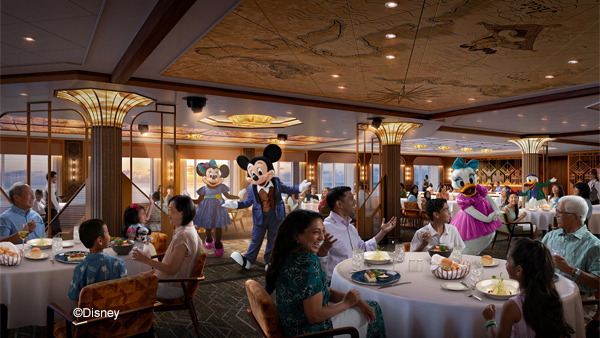
- Ship Name: Disney Adventure
- Year Built: 2025
- Year Entered Present Fleet: 2025
- Number of Passenger Decks: 19
- Officers' Nationality: International
- Ocean-View without Balcony: 67
- Ocean-View with Balcony: 1,326
- Total Inside Staterooms: 561
- Tonnage (GRT): 208,000
- Capacity Based on Double Occupancy: 6,700
- Country of Registry: The Bahamas
- Total Staterooms: 2,111
- Suites with Balcony: 145
- Crew/Hotel Staff Nationality: International
Available Dates & Prices
Terms & Conditions
*Price shown is per person based on double occupancy and is valid for select stateroom categories only. Click on Terms & Conditions link below for details.
†This cruise includes a Digital Costco Shop Card that will arrive by email approximately 10 days after the start of your cruise. The exact amount of the Digital Costco Shop Card will be calculated during the booking process. The Digital Costco Shop Card promotion is nontransferable and may not be combined with any other promotion. To receive your Digital Costco Shop Card, bookings must be made directly through Costco Travel. Bookings made through Disney Cruise Line or the Disney onboard cruise consultant must be transferred to Costco Travel's reservation system to qualify for the Digital Costco Shop Card. Click on the Terms & Conditions link below for additional information.
Ship Registry: The Bahamas
As to Disney's artwork, properties and logos: ©Disney
Digital Costco Shop Card
This booking includes a Digital Costco Shop Card which will arrive by email one to two weeks after you return from your vacation. The Digital Costco Shop Card is a convenient payment option in our warehouses and on Costco.com.










